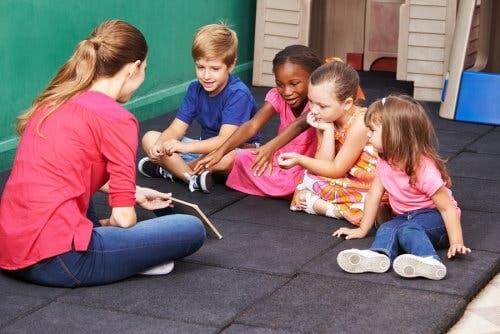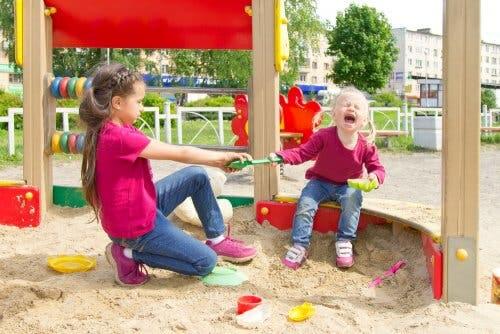Conflict Resolution Strategies in the Classroom

Inevitably, conflicts happen in schools and daycare centers. Students are at an age when they’re still learning to relate to others and manage their emotions. Sometimes, a simple misunderstanding can turn into a real conflict. Here, we’ll show you some conflict resolution strategies that you can use in the classroom.
Conflicts: can you avoid them?
Generally, a conflict happens when there’s a clash of interests or needs, either between individuals or groups.
These types of situations don’t just happen in high school or college, but in all educational centers. Conflicts are a natural and inherent fact of human character. In fact, conflict is part of daily life and life itself.
Once we understand that conflicts are part of human life in society and we can’t avoid them, we need to try to manage them in the healthiest way. The pedagogue Antonio Pantoja states that if conflict management occurs normally, from mutual respect, it can lead to interpersonal enrichment. You can also help learn new ideas and points of view.
“The man who can make hard things easy is the educator.”
– Ralph Waldo Emerson –

Preventative conflict resolution strategies in the classroom
Role playing
The founder of the Institute of Group Techniques and Psychodrama, Pablo Población, defines role playing as a method of learning through experience and, specifically, through play. In pedagogy, role playing helps anticipate, correct, evaluate and modify attitudes in social interaction.
In this case, role playing consists of students playing a role in a situation the teacher or counselor creates. This scene shows an imaginary conflict. In this way, the students learn personal skills they can use in future conflicts.
Teaching to listen: essential for conflict resolution
Frequently, most interpersonal conflicts happen because of poor communication. For example, misunderstandings cause them. So, teaching students to listen and pay attention to each other is an important conflict resolution strategy.
Here are some habits on how to be an active listener:
- Don’t interrupt, or only do so when necessary.
- Maintain eye contact, which nurtures a respectful conversation. Also, using body language, like nodding from time to time, lets the other person know you’re paying attention.
- Asking instead of correcting encourages a friendly tone in conversations. Therefore, it doesn’t fan the flames of conflict.
- Repeat what you heard in your own words. This way, you show that you paid attention to the message.
Conflict resolution strategies in the classroom
Pause to reflect and calm nerves
Giving students the opportunity to reflect on what just happened is very effective, even if the conflict happened during class. During this pause, students should identify their feelings, analyze them, and find ways to resolve the conflict.
Writing about conflict is a good strategy for students to organize their ideas, analyze themselves and observe what happened more clearly. In other words, the goal isn’t just to calm down. On the other hand, it’s also to reflect on how they could have acted to change what happened, and how to resolve the conflict.

Negotiation and mediation
One of the main conflict resolution strategies in the classroom is negotiation and mediation. Aside from being very effective, educating students on negotiation and mediation teaches them how to be peaceful. It also helps develop quality interpersonal relationships for the future.
According to Kathryn Girard and Susan Koch, specialists in conflict resolution, negotiation is a voluntary procedure for solving problems between the conflicting parties. The goal is to reach an agreement that benefits both parties.
On the other hand, mediation requires the help of a neutral third party. In this case, this is either a teacher or counselor. Then, the mediator brings the parties together to recommend an agreement that may go beyond the interests of the parties. This is because it takes into account the context and rules of the school.
“Cooperation isn’t the absence of conflict but a means of managing conflict.”
– Deborah Tannen –
In short, teaching conflict resolution strategies to children and teens doesn’t just end the conflict in the moment. It educates and trains students in emotion management, problem solving and interpersonal skills.
Inevitably, conflicts happen in schools and daycare centers. Students are at an age when they’re still learning to relate to others and manage their emotions. Sometimes, a simple misunderstanding can turn into a real conflict. Here, we’ll show you some conflict resolution strategies that you can use in the classroom.
Conflicts: can you avoid them?
Generally, a conflict happens when there’s a clash of interests or needs, either between individuals or groups.
These types of situations don’t just happen in high school or college, but in all educational centers. Conflicts are a natural and inherent fact of human character. In fact, conflict is part of daily life and life itself.
Once we understand that conflicts are part of human life in society and we can’t avoid them, we need to try to manage them in the healthiest way. The pedagogue Antonio Pantoja states that if conflict management occurs normally, from mutual respect, it can lead to interpersonal enrichment. You can also help learn new ideas and points of view.
“The man who can make hard things easy is the educator.”
– Ralph Waldo Emerson –

Preventative conflict resolution strategies in the classroom
Role playing
The founder of the Institute of Group Techniques and Psychodrama, Pablo Población, defines role playing as a method of learning through experience and, specifically, through play. In pedagogy, role playing helps anticipate, correct, evaluate and modify attitudes in social interaction.
In this case, role playing consists of students playing a role in a situation the teacher or counselor creates. This scene shows an imaginary conflict. In this way, the students learn personal skills they can use in future conflicts.
Teaching to listen: essential for conflict resolution
Frequently, most interpersonal conflicts happen because of poor communication. For example, misunderstandings cause them. So, teaching students to listen and pay attention to each other is an important conflict resolution strategy.
Here are some habits on how to be an active listener:
- Don’t interrupt, or only do so when necessary.
- Maintain eye contact, which nurtures a respectful conversation. Also, using body language, like nodding from time to time, lets the other person know you’re paying attention.
- Asking instead of correcting encourages a friendly tone in conversations. Therefore, it doesn’t fan the flames of conflict.
- Repeat what you heard in your own words. This way, you show that you paid attention to the message.
Conflict resolution strategies in the classroom
Pause to reflect and calm nerves
Giving students the opportunity to reflect on what just happened is very effective, even if the conflict happened during class. During this pause, students should identify their feelings, analyze them, and find ways to resolve the conflict.
Writing about conflict is a good strategy for students to organize their ideas, analyze themselves and observe what happened more clearly. In other words, the goal isn’t just to calm down. On the other hand, it’s also to reflect on how they could have acted to change what happened, and how to resolve the conflict.

Negotiation and mediation
One of the main conflict resolution strategies in the classroom is negotiation and mediation. Aside from being very effective, educating students on negotiation and mediation teaches them how to be peaceful. It also helps develop quality interpersonal relationships for the future.
According to Kathryn Girard and Susan Koch, specialists in conflict resolution, negotiation is a voluntary procedure for solving problems between the conflicting parties. The goal is to reach an agreement that benefits both parties.
On the other hand, mediation requires the help of a neutral third party. In this case, this is either a teacher or counselor. Then, the mediator brings the parties together to recommend an agreement that may go beyond the interests of the parties. This is because it takes into account the context and rules of the school.
“Cooperation isn’t the absence of conflict but a means of managing conflict.”
– Deborah Tannen –
In short, teaching conflict resolution strategies to children and teens doesn’t just end the conflict in the moment. It educates and trains students in emotion management, problem solving and interpersonal skills.
All cited sources were thoroughly reviewed by our team to ensure their quality, reliability, currency, and validity. The bibliography of this article was considered reliable and of academic or scientific accuracy.
- Girad, K. y Koch, S.J. (2001). Resolución de conflictos en las Escuelas. Ediciones Granica. España: Barcelona.
- López, E. y Población, P. (2000). Introducción al Role-playing pedagógico. Desclée de Brouwer. España.
- Pantoja, A. (2005). La gestión de conflictos en el aula. Factores determinantes y propuestas de intervención. Factores y determinantes y propuestas de intervención. La orientación escolar en centros educativos. Ministerio de Educación y Ciencia de España.
This text is provided for informational purposes only and does not replace consultation with a professional. If in doubt, consult your specialist.








